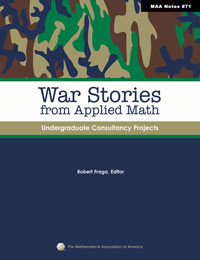- About MAA
- Membership
- MAA Publications
- Periodicals
- Blogs
- MAA Book Series
- MAA Press (an imprint of the AMS)
- MAA Notes
- MAA Reviews
- Mathematical Communication
- Information for Libraries
- Author Resources
- Advertise with MAA
- Meetings
- Competitions
- Programs
- Communities
- MAA Sections
- SIGMAA
- MAA Connect
- Students
- MAA Awards
- Awards Booklets
- Writing Awards
- Teaching Awards
- Service Awards
- Research Awards
- Lecture Awards
- Putnam Competition Individual and Team Winners
- D. E. Shaw Group AMC 8 Awards & Certificates
- Maryam Mirzakhani AMC 10 A Awards & Certificates
- Two Sigma AMC 10 B Awards & Certificates
- Jane Street AMC 12 A Awards & Certificates
- Akamai AMC 12 B Awards & Certificates
- High School Teachers
- News
You are here
War Stories from Applied Math: Undergraduate Consultancy Projects

Robert Fraga, Editor
Catalog Code: NTE-71
Print ISBN: 978-0-88385-181-4
Electronic ISBN: 978-0-88385-977-3
160 pp., Paperbound, 2007
List Price: $48.95
MAA Member: $36.75
Series: MAA Notes
To order a print copy, call the MAA Service Center at (800) 331-1622.
This book deals with issues involved in setting up and running a program which allows undergraduate students to work on problems from real world sources. A number of practitioners share their experiences with the reader. How are such programs set up and what resources are required? How are clients found? What problems are suitable for students to work on? What difficulties can be anticipated and how can they be resolved? What benefits do the clients derive from the student’s work and what do the students get out of such projects? These issues and others like them are explored in a number of different academic environments. It is the contention of this book that students develop an appreciation of mathematics and its usefulness by engaging in programs such as those described here. Furthermore it is possible to develop such programs for a variety of student audiences over a wide spectrum of colleges and universities. A chapter is devoted to relevant materials available from the Consortium for Mathematics and its Applications (COMAP). Lists of students’ projects and examples of their work are provided. There is also a discussion of the pros and cons of consultancy projects by representatives of industry familiar with such projects.
Table of Contents
Introduction
An Industrial Mathematics Program, George Corliss
Source of Problems: Industrial Contacts, Robert Borrelli
Panel Discussion Following “Industrial Contacts”
Course Integration, George Corliss
The Consortium of Mathematics and Its Applications (COMAP), Paul Campbell
Program Management, Martha Siegel
Project Deliverables I, Robert Borrelli
Project Deliberables II, Tom Davis
Using Projects from Industry to Teach Mathematics and Statistics to Liberal Arts Majors, Daniel Maki
Mathematical Modeling in ICIC Projects, Robert Fraga
Appendix: A Sample of HMC Report
Excerpt: Introduction (p. 1)
What good is mathematics? What is supply-your-favorite-topic-commonly-taught-in-any-math-course used for?
Have you ever had undergraduate students ask either of these questions? If not, you are in a very small minority of college math teachers, probably a set of measure zero. If you have had either of these questions asked, how do you answer? The first question is such a blockbuster that it invites a sweeping reply although one that could be given incrementally: Bar codes to bridges. The second question cannot be satisfactorily answered without some feel for the interests of the person asking the question. Suppose it is pre-med students who ask this question. They will be satisfied by an answer that relates to their professional interest. Geometric series, for example, have application in determining the concentration of a certain drug in a patient’s blood system after a treatment of periodic injections, to cite an example drawn from an introductory course in calculus. But a business or an economics major will not find this answer particularly satisfying. Such a student will be happier with an example drawn from the accruing value of a bank account into which periodic payments are made.
This collection deals with these questions but from a somewhat different point of view. Problems are identified and, given the nature of those problems, the appropriate mathematics is brought to hear on their solutions. More specifically, the problems are drawn from sources in what is called–perhaps a tad pretentiously–the Real World. This is to say that mathematicians seek out problems from business, industrial, and local government sources and turn their students loose on these problems with varying amounts of assistance provided by faculty.
The origin of some of this collection was a workshop given at Marquette University in Milwaukee, Wisconsin, during the summer of 1996. This workshop, funded by a grant from the National Science Foundation (NSF), brought together four mathematicians involved, one way or another, in undergraduate consultancy projects, representatives from industry, and an audience of mathematicians interested in trying out the ideas presented by them. A unique aspect of the workshop was the inclusion of representatives of client companies who commented on their own experiences and their perceptions of student work in a business/industrial context.
The chapters that follow are adaptations of transcripts made at the workshop. We contend that the material herein is as relevant today as it was ten years ago, but with the passage of time, it has been necessary to update that material and each of the contributing authors has graciously done so. There are three supplementary chapters containing material that was not presented at the Marquette workshop: The opening chapter, An Industrial Mathematics Program, is based on a talk which George Corliss gave to an audience at the institution which is now called the University of Louisiana at Lafayette. It is an excellent overview of the subject of this collection. The two concluding chapters by Dan Maki and myself (Robert Fraga) are also supplementary. A sample student group report from the Math clinic at Harvard Mudd College, in a slightly edited version, is provided as an appendix.
Tags:
Book Series:




